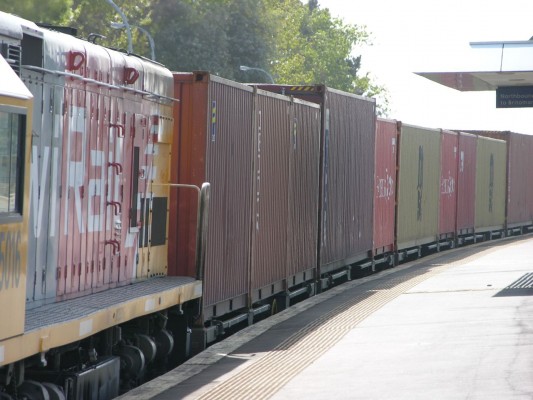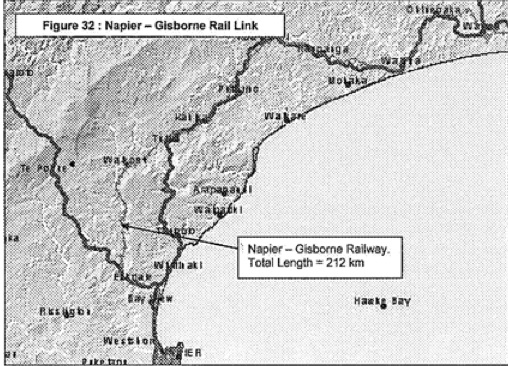Gisborne-Napier’s Rail Survival: The Hard Facts
There are a few new bites about moving freight on the Napier-Gisborne rail line but a Council report reveals the facts and figures of what it will take to make rail not run at its present loss.
The Hawke’s Bay Council’s transport committee yesterday considered a report about the line.
There are 340 trucks a day on the state highway to Gisborne each carrying about 29 tonnes. That would make the total freight load on the highway to carry 3.6m tonnes a year.
If all this was transferred to rail it would keep the service going. The volume of freight would be the equivalent of running 15 fully-loaded return trains a day between Napier and Gisborne.
The report says at the present rate a subsidy of more than $2m a year would be needed to keep it going but even that would not make an appreciable difference to the future of the rail service.
KiwiRail is already effectively subsidising the service at a cost of at least $2.5m a year in terms of the loss. The service is still shifting only the equivalent of one or 2 truckloads of freight a day.
A KiwiRail decision on its future is a year away.
KiwiRail says gross income last year was $586,719. That compares with $2m in line maintenance costs on top of running the trains ($1m a year).
The Council officers’ report to the Council committee said that in the short-term a closure of the line would have only a minor effect on heavy traffic volumes on the state highway. In the last year the rail service moved just 23,600 tonnes of freight in both directions combined.
Converted to road-truck equivalents, that’s the same as a single truck carrying 32 tonnes doing a return trip to Gisborne each day.
But it warns that in the long-term a closure of the line would mean the region would have one less mode of freight transport and once closed, it would not be simple to resurrect it.
And the report before the Council suggests that while higher fuel prices could make a difference, if fuel efficiency is the deciding factor for freight, coastal shipping also needs to be part of the picture.
There are presently just 2 return trains a week on the line. Most of the freight is fertiliser from Ravensdown in Napier although its carrying more by road these days. Other freight includes corn product from Corsons in Gisborne (3-8 containers a month) and frozen product for Heniz-Wattie in Hastings (5 containers a week during the picking season).

KIWIRAIL: What's ahead?
The Council report believes that freight users are preferring road transport because of its comparative flexibility and convenience of road freight and the only way rail can compete on pricing is to run at a loss. It’s not possible on current volumes and with all the fixed costs involved to on-charge the full cost of the rail service to the customer.
The report goes on:”In order to be financially viable the rail service needs to attract enough freight to not only cover the costs of running the service but also to arrive at a point where the per unit costs has been reduced sufficiently to genuinely compete.”
It says the economics are also constrained by towing capacities- limits placed on weight. For example, with existing gradients a DC locomotive can tow 840 tonnes and a DXB 940. That leaves 320,580 and 650 tonnes respectively for freight. On the same the same amount of freight could be carried by 10, 18 and 20 trucks carrying 32 tonnes each.
The report notes that in the last 30 years road travel time between Napier and Gisborne has been cut by about an hour and fuel consumption of the average road truck has dropped by a third while rail has not seen big improvements.
“The fuel efficiency of road and rail has therefore come closer together- although rail is ahead.
It’s estimated a fully laden DX locomotive on the Gisborne line would use about 52% of the fuel consumption of the number of trucks required to carry the same amount of freight.

Until recently the real prospect for rail was a new plywood mill constructed by Hikurangi Forest Farms in Gisborne but those plans have been put indefinitely on hold.
The report says that even if the mill went ahead, it would remain to be seen if rail was used as the company did not make that commitment.
As more trees come to maturity in the far north of the region and if there’s a shortage of logging trucks, this may be a niche for rail and KiwiRail is talking to local forest companies.
The local newspaper reports a few bites coming through. Four extra weekly services would start next month and another potentially large customer had been turned away because of a lack of equipment and crews.
Let’s hope that issue gets sorted.

In conclusion, the report says that if the log service happens and works successfully and can be proven over the next 12 months, then other freight could possibly follow and the rail service may become economic.
If that does not occur, then a next priority could be to ensure that the rail designation and rail corridor are at least retained intact so that future options for re-utilisation of the rail corridor are preserved.











8 Comments
Good coverage Jon, thanks.
but surely it’s more than 29t/year carried by road? that alone could be carried by two truck & trailer units?
Is the full cost of maintaining the road met by the users of that road directly, or is it funded by the whole network?
If this kind of accounting was taken to roads every rural road in the country would have to be scrapped.
This is managed destruction of our asset. And death by a thousand cuts for the network as a whole.
Yes more business on this and other lines is vital, but this narrow form of analysis is precisely what big trucking wants but would never support being applied to their mode.
We will pay more through road works and road deaths. There are valuable unaccounted benefits to rail freight and expensive and dangerous deficits to road freight that are similarly not costed.
@Jeff Sorry I lost a line . Corrected now.
todays story in the DomPost that outlines the growth now being experienced should put any suggestions of the line being shut to bed.
Obvious that Kiwirail should partner with Weatherall Transport, the big local truckers. Seasonal work isnt good for the truckers so theyll be glad to put it on rail.
Hopefully this model is rolled out elsewhere.
Once again we hear another story that there are actually customers out there but Kiwirail turn them away. This seems to be a theme along many of these lines and I assume it has been going on for a while which is probably a large reason why rail is in the state it is in.
I realise there has been a large history of under investment in many areas but just turning customers away isn’t a great way to build good relationships with people.
Exactly Matt. It`s not that there aren`t customers out there. Kiwirail just never seems to be in a position to take advantage of the fact or can`t seem to be bothered. Maybe they just see keeping the Gisborne-Napier Line as just too much of a hassle to be worth it even if there are some customers around.
Jeepers, if this was a European or even an Australian based company, then they would be leaping at that chance of getting more customers and saving the line.
Pick up the Slack Kiwirail.
Makes depressing reading especially the turning away of business quotes. Whether it’s from lack of rolling stock committment or just apathy who knows. I was quoted $45,000 to charter a train from Auckland to National park for ski seasons seemed over the top to me. But in Kiwirails defence they did recieve a hosptial pass from Toll with run down trackage rolling stock and locomotives. Just where the 3million loss is coming from is anyone’s guess but I suspect a heavy weighting towards management and depreciation…. both old tried and true accounting mumbo jumbo for “lets create an excuse to can this totally” or in National’s terms “Mothball”.. anyone remember that tourism is our second biggest earner and rail is a great safe way for tourists to see the country.